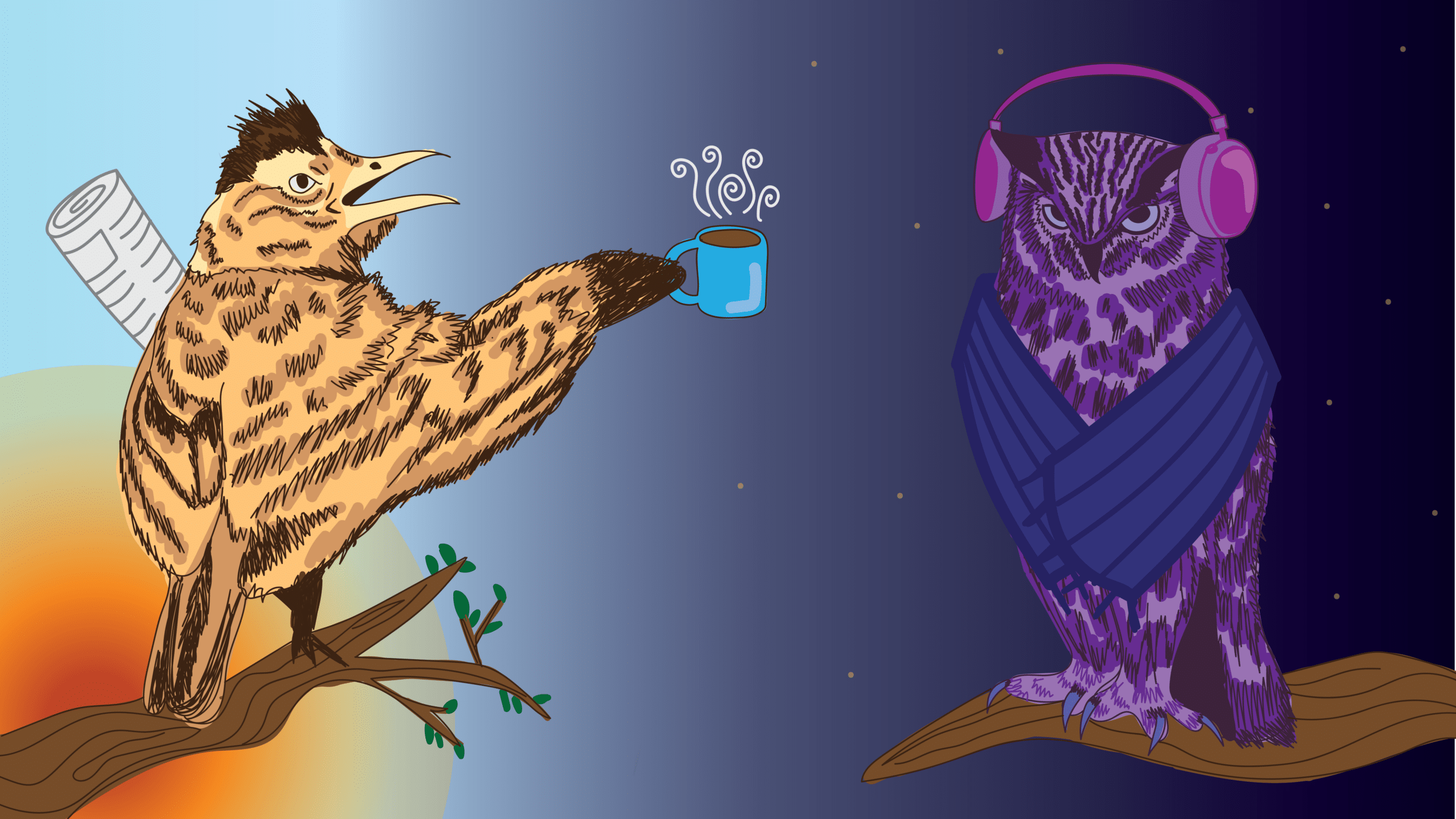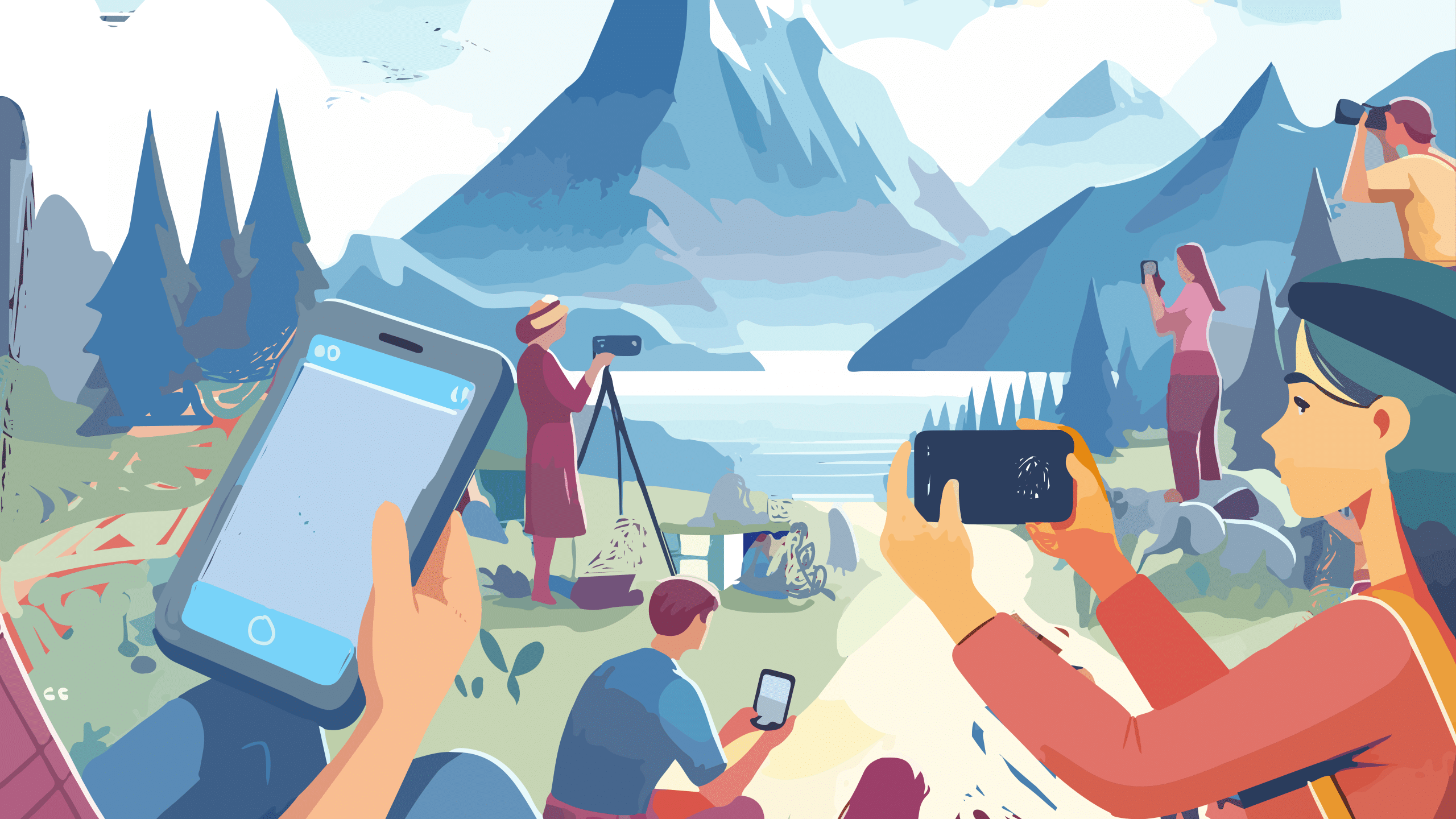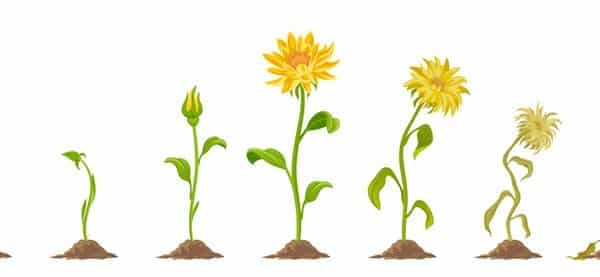The question of if the early bird gets the worm has been studied since the 1970s. Now, science can explain the advantages and disadvantages of each chronotype, including how each can achieve better sleep and higher productivity levels.
Are You a Night Owl or an Early Bird?
Chances are, you already know if you are a “morning person” or a “night person,” aka an “early bird” or a “night owl.” Generally speaking, early birds are most active in the morning. They tend to wake up early and go to bed early. In contrast, night owls have more energy at night. They prefer to stay up late and sleep in.
However, there are many more factors to consider before identifying with one of those typical categories. In fact, it turns out that early birds and night owls are not the only chronotypes.
Chronotype refers to the internal circadian rhythm or body clock of an individual that influences the sleep cycle and activity in a 24-hour period. Circadian rhythms pertain to drowsiness and alertness levels. While similar, the two are not the same. Instead, chronotypes can be viewed as a guide to how your circadian rhythm influences your everyday life.
Since studies surrounding chronotypes began in the 1970s, they have since been expanded to include four chronotypes. Today’s standard chronotypes include the bear, the wolf, the lion, and the dolphin.
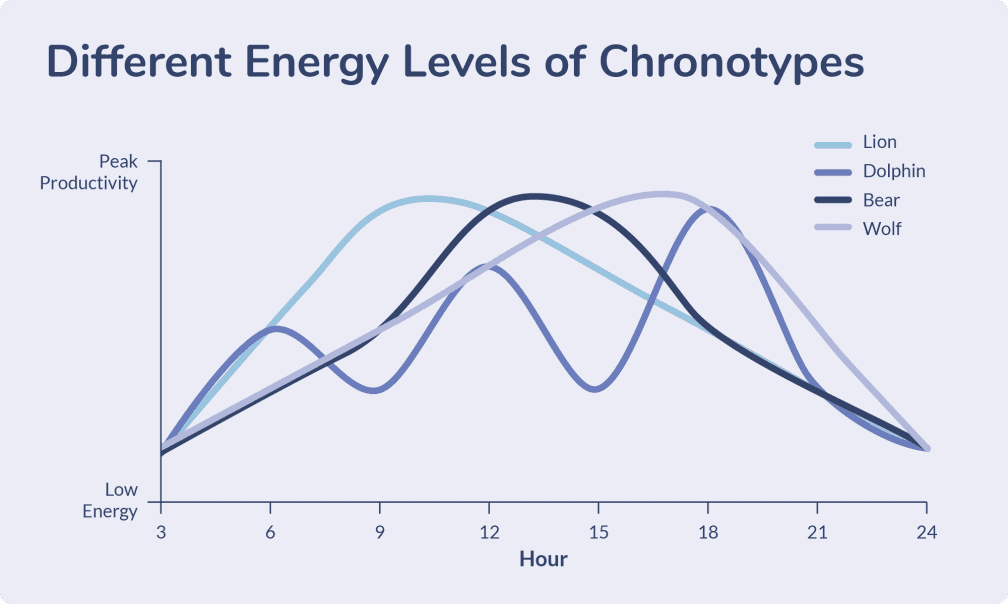
Most similar to the idea of the early bird is the lion. The lion feels most awake in the morning with energy levels that peak before noon (8:00 a.m. to 12:00 p.m.). Lions can easily wake up early but often feel drained by evening time. They typically wake up around 6:00 a.m. and go to bed around 10:00 p.m. Lions account for 15% of the population.
Most similar to the idea of the night owl is the wolf. The wolf prefers to hit snooze in the morning, typically waking up around 7:30 a.m. or later. However, wolves do not get their first burst of energy until around noon, with another around 6:00 p.m. That means that a wolf best focuses from 5:00 p.m. to 12:00 a.m., and often goes to bed around midnight or later. Wolves also account for 15% of the population.
Straying from the two typically thought-of chronotypes are the bear and the dolphin.
The bear is the most common chronotype, accounting for 55% of the population. The bear most adheres to the solar cycle, waking up around 7:00 a.m. and going to bed around 11:00 p.m. They are most productive between 10:00 a.m. and 2:00 p.m., but often struggle with an afternoon slump.
Lastly, and most atypical of the chronotypes, is the dolphin, accounting for only 10% of the population. Dolphins typically (and begrudgingly) awake around 6:30 a.m. and go to sleep around 11:30 p.m. While their window of focus lasts from 3:00 p.m. to 9:00 p.m., dolphins often need breaks throughout the day. That is due to their anxious and sporadic sleeping habits which often result in poor sleep quality.
There are multiple determinants that affect an individual’s circadian rhythm and/or chronotype. Lightness and darkness have the biggest influence on circadian rhythms. However, food intake, stress, physical activity, social environment, and temperature may also play a role.
If you are curious about which chronotype you are, you can take this free quiz in under five minutes.
Does the Early Bird Get the Worm?
There are several sayings you may have heard before that favor the early bird. For example, “The early bird gets the worm,” or “Early to rise makes you healthy, wealthy and wise.” In reality, all four chronotypes come with different sets of advantages, disadvantages, and unique traits.
Perhaps most advantageous of all is the early bird’s (aka lion’s) ability to adhere to society’s typical 9-5 schedule. That alone gives them advantages in both furthering their education and finding suitable careers. Additionally, early birds are usually more proactive, sociable, agreeable, and healthier overall. Early birds/lions are also more charismatic and more likely to be natural leaders.
On the other hand, early risers face disadvantages as well. For example, early birds require more sleep (around eight hours). They also do not get sudden bursts of energy throughout the day, such as dolphins do. Early birds/lions start the day at full capacity and slowly wind down, decreasing their ability to perform.
Night owls/wolves have their fair share of advantages too. For one, night owls are typically more intelligent, and are highly creative and introspective. Unlike early birds, late risers’ energy slowly increases as the day unravels. That, in combination with their ability to focus on tasks for longer periods of time, allows them to be, overall, more productive.
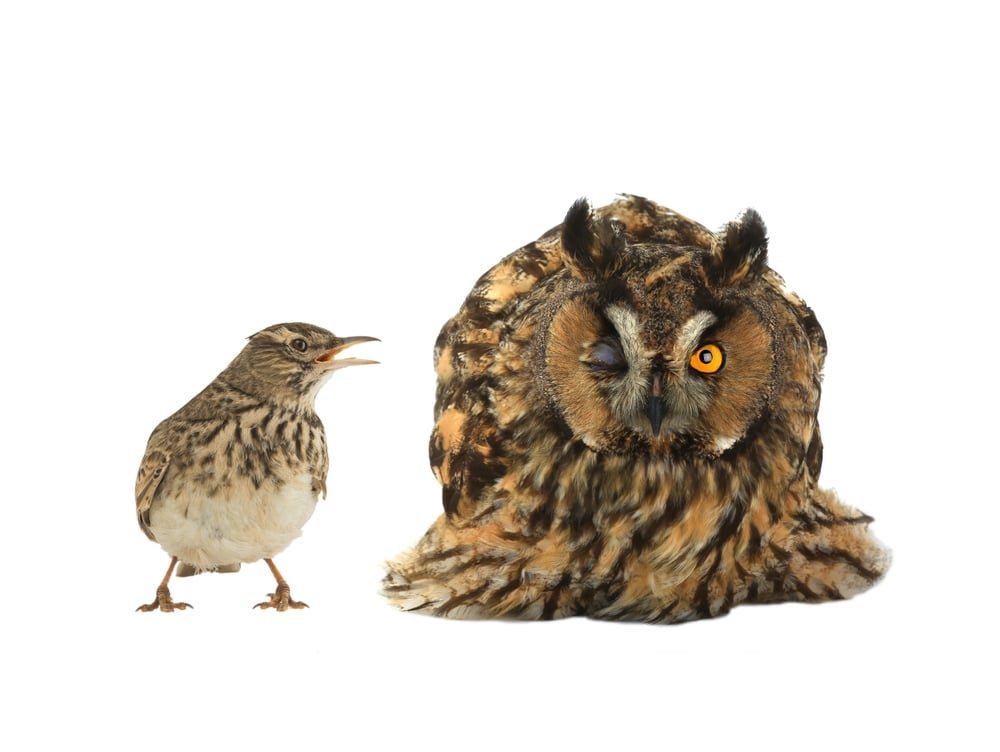
Of course, in a world where “life takes place during the day,” night owls face several disadvantages. Night owls/wolves have a difficult time abiding by the typical 9-5 schedule, and often work better as freelancers.
However, they must still utilize daytime to do non-work activities otherwise not available (like grocery shopping or running errands). That means night owls/wolves often squeeze in such activities during the day on top of staying up late to work.
Lastly, because night owls spend more time awake during the isolated hours of the night, they are also more prone to mood disorders. Night owls/wolves are more likely to suffer from depression, loneliness, and higher levels of stress and anxiety due to social jetlag. Perhaps going hand-in-hand with their susceptibility to mood disorders, night owls/wolves are also more susceptible to substance abuse.
As far as the remaining two chronotypes, bears have the advantage of being the majority of the population. They usually do not have much trouble waking up or falling asleep, but it is important for them to get eight hours of sleep. Bears have the advantages of being “happy-go-lucky” extroverts and of having a continuous flow of mellow energy throughout the day.
Dolphins face the unique challenge of underlying tiredness throughout the day due to their anxious sleeping habits. Those include having a hard time falling asleep, staying asleep, and waking up. Sometimes, their underlying tiredness may cause dolphins to seem “distant” or “uninterested” during social interactions. However, dolphins have the advantages of being highly intelligent and experiencing multiple bursts of creative energy throughout the day.
No matter your chronotype and no matter the different struggles you may face, you can create a schedule that works best for you. To get the best sleep possible, maximize productivity, and reduce tiredness, the Sleep Foundation recommends the following schedules for each chronotype.
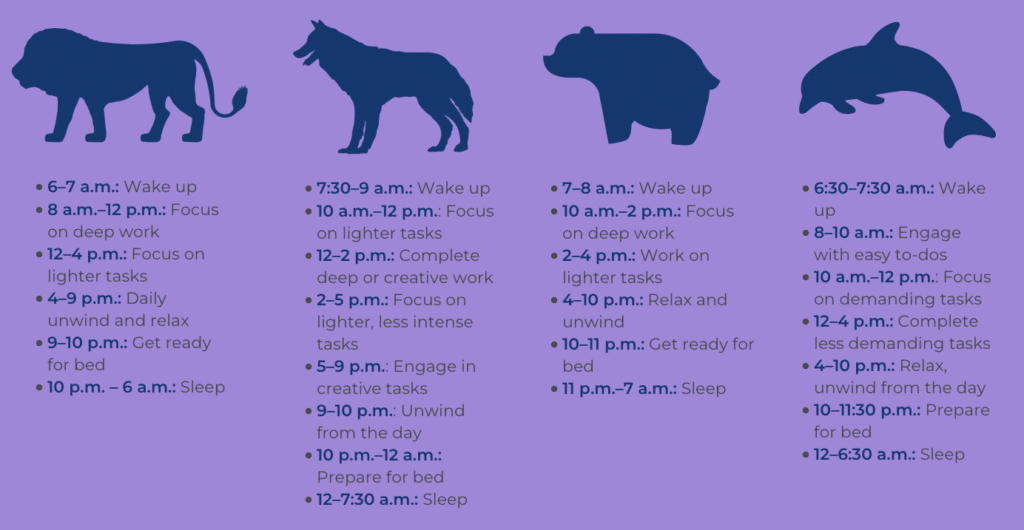
Based on information from here.
Besides establishing a routine, there are other courses of action recommended by specialists that can also help you improve your sleep quality. For example, it is recommended to use blackout curtains and reduce excess light.
You should avoid using electronic devices right before bed; instead, do something relaxing like reading or journaling. Getting the recommended amount of exercise each day and avoiding caffeinated beverages is also beneficial.
Learn more hacks for getting better sleep here or read on about how sleep fuels success.
Getting the proper amount of sleep, and good sleep, is very important. Good sleep improves both mental and physical health, cognitive performance, and the immune system. If not taken seriously, the effects of sleep deprivation can build up over time. Those effects can cause serious issues that may impact your health and daily life.
Gen Zzz: Are Younger People Embracing Earlier Bedtimes?
Straying from the conventional image of the youth as night owls, research has found that Gen Z is increasingly embracing earlier bedtimes.
A study conducted by Sleep Number concluded that Gen Z is actually more likely than any other generation to prioritize getting enough sleep. Young people report shifting in that direction to optimize well-being and mental health, and to promote a healthier lifestyle.
Instead of indulging in night life, many young people are now prioritizing early nights and self care. For example, self care trends have been widely popularized on TikTok, such as the #earlynight trend and the #sleepygirlmocktail trend.
Young people also point out that skipping out on the night scene does not mean sacrificing your social life. In fact, Gen Z and Millennials are now kicking binge drinking habits at higher rates than most generations before.
However, there are still quite a few members of Gen Z who thrive at night. Recent studies have found that a number of young people wish their workday started at 6 p.m. in contrast to the usual 9-5.
It seems a new question has arisen in place of “Does the early bird get the worm?” Now, young people are wondering if the business world will ever shift from the 9-5 schedule to find a compromise which fits all chronotypes.


